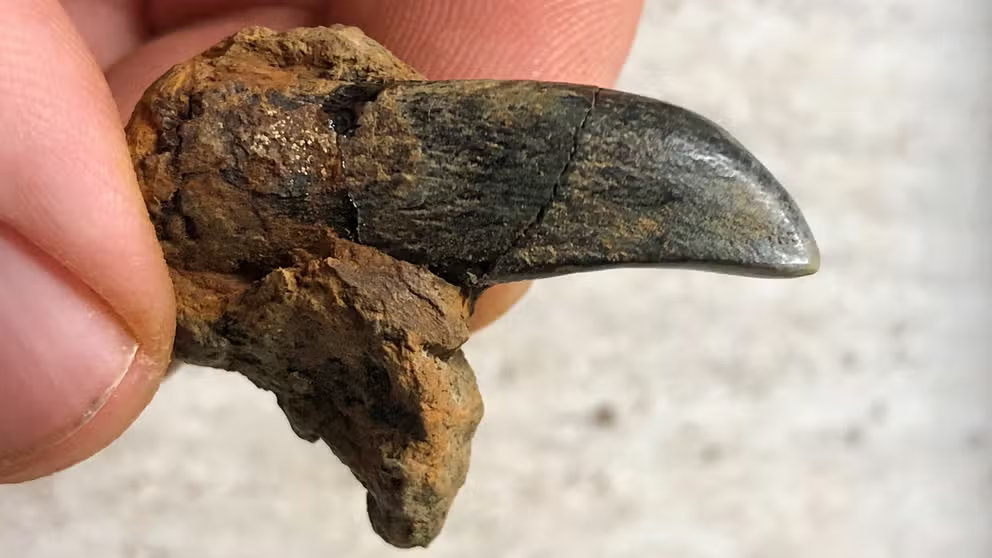Fossil of 240-million-year-old 'dragon' unearthed in China
National Museums Scotland announced the discovery of a fossil belonging to the Dinocephalosaurus orientalis, which has an unusually long neck with 32 vertebrae and flippered limbs. The fossil also contains well-preserved fish in the stomach region.
How kids at Dinosaur Park are finding bones with help from the rain
File: Located in Laurel, Maryland, Dinosaur Park is an outdoor laboratory where paleontologists, park visitors, and the weather combine forces to discover hundreds of fossils.
EDINBURGH, Scotland – An international team of scientists discovered new fossils of a 16-foot-long aquatic reptile that lived approximately 240 million years ago.
"We are certain that it will capture imaginations across the globe due to its striking appearance, reminiscent of the long and snake-like, mythical Chinese dragon," said Nick Fraser, keeper of natural sciences at the National Museums Scotland, where the fossils were unveiled.
Scientists have identified the remains of Dinocephalosaurus orientalis, a species from the Triassic period in China. The fossils were discovered in the Guizhou Province of southern China.
'DINOSAUR-LIKE' SNAPPING TURTLE MYSTERIOUSLY DISCOVERED IN UK - AN OCEAN APART FROM US HOME

Dinocephalosaurus orientalis swimming alongside some prehistoric fish known as Saurichthys.
(Marlene Donelly, National Museums of Scotland)
Scientists first discovered the reptile in 2003, but they could not fully describe it due to incomplete specimens. Additional and more complete specimens were found, including the most recent preserved in the same posture it was buried.
"This discovery allows us to see this remarkable long-necked animal in full for the very first time," Fraser said. "It is yet one more example of the weird and wonderful world of the Triassic that continues to baffle palaeontologists."
‘EXTREMELY RARE’ JURASSIC FOSSILS DISCOVERED IN SOUTHERN UTAH
The sea creature displayed an unusually long neck comprised of 32 vertebrae, giving the animal a snake-like appearance.
Its sharp teeth allowed it to easily catch fish and was clearly very well adapted to an oceanic lifestyle, as indicated by the flippered limbs and exquisitely preserved fish in its stomach region, paleontologists said.
Although Dinocephalosaurus may share some similarities with the long-necked plesiosaurs, it is not closely related to them, scientists add. The plesiosaurs only evolved around 40 million years later and inspired the myth of the Loch Ness Monster.
DISCOVERED DINOSAUR BONE IN ENGLAND MIGHT HAVE BELONGED TO CENTURIES-OLD FIRST ROMAN FOSSIL HUNTERS

Dinocephalosaurus orientalis.
(National Museums of Scotland)
Scientists from multiple countries studied the fossil for ten years at the Institute of Vertebrate Palaeontology and Palaeoanthropology in Beijing.
"This has been an international effort," Professor Li Chun from the Institute of Vertebrate Palaeontology and Palaeoanthropology said. "Working together with colleagues from the United States of America, the United Kingdom and Europe, we used newly discovered specimens housed at the Chinese Academy of Sciences to build on our existing knowledge of this animal."
JOGGER'S PREHISTORIC FIND ALONG CALIFORNIA BEACH WOWS MUSEUM COLLECTORS
Scientists suggest that future research will enhance their understanding of the evolution of this animal group, especially with regard to the function of their elongated necks.
The paper describing Dinocephalosaurus orientalis is published in Earth and Environmental Science: Transactions of the Royal Society of Edinburgh.
